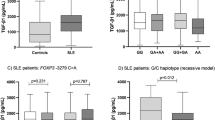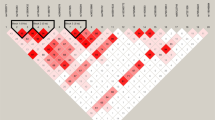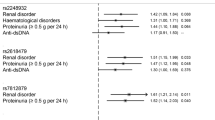Abstract
Complement cascade plasma proteins play a complex role in the etiopathogenesis of systemic lupus erythematosus (SLE). Hereditary C1q deficiency has been strongly related to SLE; however, there are very few published SLE studies that evaluate the polymorphisms of genes encoding for C1q (A, B and C). In this study, we evaluated 17 single nucleotide polymorphisms (SNPs) across 37 kb of C1QA, C1QB and C1QC in a lupus cohort of individuals of the African-American and Hispanic origin. In a case-only analysis, a significant association at multiple SNPs in the C1QA gene was detected in African Americans with kidney nephritis (best P=4.91 × 10−6). In addition, C1QA was associated with SLE in African Americans with a lack of nephritis and accompanying photosensitivity when compared with that in normal controls (P=6.80 × 10−6). A similar trend was observed in the Hispanic subjects (P=0.003). Quantitative analysis showed that some SNPs in C1q genes might be correlated with C3 complement levels in an additive model among African Americans (best P=0.0001). The C1QA gene is associated with subphenotypes of lupus in the African-American and Hispanic subjects. Further studies with higher SNP densities in this region and other complement components are necessary to elucidate the complex genetics and phenotypic interactions between complement components and SLE.
This is a preview of subscription content, access via your institution
Access options
Subscribe to this journal
Receive 6 digital issues and online access to articles
$119.00 per year
only $19.83 per issue
Buy this article
- Purchase on Springer Link
- Instant access to full article PDF
Prices may be subject to local taxes which are calculated during checkout

Similar content being viewed by others
References
Hauptmann G, Grosshans E, Heid E . Lupus erythematosus syndrome and complete deficiency of the fourth component of complement. Boll Ist Sieroter Milan 1974; 53 (Suppl): 228.
Pickering MC, Botto M, Taylor PR, Lachmann PJ, Walport MJ . Systemic lupus erythematosus, complement deficiency, and apoptosis. Adv Immunol 2000; 76: 227–324.
Hannema AJ, Kluin-Nelemans JC, Hack CE, Eerenberg-Belmer AJ, Mallée C, van Helden HP . SLE like syndrome and functional deficiency of C1q in members of a large family. Clin Exp Immunol 1984; 55: 106–114.
Carroll MC . The complement system in B cell regulation. Mol Immunol 2004; 41: 141–146.
Bird P, Lachmann PJ . The regulation of IgG subclass production in man: low serum IgG4 in inherited deficiencies of the classical pathway of C3 activation. Eur J Immunol 1988; 18: 1217–1222.
Glass D, Raum D, Gibson D, Stillman JS, Schur PH . Inherited deficiency of the second component of complement. Rheumatic disease associations. J Clin Invest 1976; 58: 853–861.
Lachmann PJ . Genetic deficiencies of the complement system. Boll Ist Sieroter Milan 1974; 53 (Suppl): 195–207.
Brai M, Accardo P, Bellavia D . Polymorphism of the complement components in human pathology. Ann Ital Med Int 1994; 3: 167–172.
Walport MJ, Davies KA, Botto M . C1q and systemic lupus erythematosus. Immunobiology 1998; 199: 265–285.
Petry F, Hauptmann G, Goetz J, Grosshans E, Loos M . Molecular basis of a new type of C1q-deficiency associated with a non-functional low molecular weight (LMW) C1q: parallels and differences to other known genetic C1q-defects. Immunopharmacology 1997; 38: 189–201.
Racila DM, Sontheimer CJ, Sheffield A, Wisnieski JJ, Racila E, Sontheimer RD . Homozygous single nucleotide polymorphism of the complement C1QA gene is associated with decreased levels of C1q in patients with subacute cutaneous lupus erythematosus. Lupus 2003; 12: 124–132.
Sellar GC, Blake DJ, Reid KB . Characterization and organization of the genes encoding the A-, B-, and C-chains of human complement subcomponent C1q: the complete derived amino acid sequence of human C1q. Biochem J 1991; 274: 481–490.
Vilá LM, Alarcón GS, McGwin Jr G, Bastian HM, Fessler BJ, Reveille JD et al. Systemic lupus erythematosus in a multiethnic US cohort, XXXVII: association of lymphopenia with clinical manifestations, serologic abnormalities, disease activity, and damage accrual. Arthritis Rheum 2006; 5: 799–806.
Hoffman IE, Peene I, Meheus L, Huizinga TW, Cebecauer L, Isenberg D et al. Specific antinuclear antibodies are associated with clinical features in systemic lupus erythematosus. Ann Rheum Dis 2004; 9: 1155–1158.
Chew CH, Chua KH, Lian LH, Puah SM, Tan SY . PCR-RFLP genotyping of C1q mutations and single nucleotide polymorphisms in Malaysian patients with systemic lupus erythematosus. Hum Biol 2008; 80: 83–93.
Martens HA, Zuurman MW, de Lange AH, Nolte IM, van der Steege G, Navis GJ et al. Analysis of C1q polymorphisms suggests association with SLE, serum C1q and CH50 levels and disease severity. Ann Rheum Dis 2009; 68: 715–720. 26 May 2008.
Petry F, Loos M . Common silent mutations in all types of hereditary complement C1q deficiencies. Immunogenetics 2005; 57: 566–571. e-pub 29 September 2005.
Miura-Shimura Y, Nakamura K, Ohtsuji M, Tomita H, Jiang Y, Abe M et al. C1q regulatory region polymorphism down-regulating murine c1q protein levels with linkage to lupus nephritis. J Immunol 2002; 169: 1334–1339.
Marto N, Bertolaccini ML, Calabuig E, Hughes GR, Khamashta MA . Anti-C1q antibodies in nephritis: correlation between titers and renal disease activity and positive predictive value in systemic lupus erythematosus. Ann Rheum Dis 2005; 64: 444–448.
Racila E, Link BK, Weng WK, Witzig TE, Ansell S, Maurer MJ et al. A polymorphism in the complement component C1qA correlates with prolonged response following rituximab therapy of follicular lymphoma. Clin Cancer Res 2008; 14: 6697–6703.
Racila E, Racila DM, Ritchie JM, Taylor C, Dahle C, Weiner GJ . The pattern of clinical breast cancer metastasis correlates with a single nucleotide polymorphism in the C1qA component of complement. Immunogenetics 2006; 1: 1–8.
Kaufman KM, Kelly JA, Herring BJ, Adler AJ, Glenn SB, Namjou B et al. Evaluation of the genetic association of the PTPN22 R620W polymorphism in familial and sporadic systemic lupus erythematosus. Arthritis Rheum 2006; 54: 2533–2540.
Jacob CO, Reiff A, Armstrong DL, Myones BL, Silverman E, Klein-Gitelman M et al. Identification of novel susceptibility genes in childhood-onset systemic lupus erythematosus using a uniquely designed candidate gene pathway platform. Arthritis Rheum 2007; 56: 4164–4173.
Cooper GS, Parks CG, Treadwell EL, St Clair EW, Gilkeson GS, Cohen PL et al. Differences by race, sex and age in the clinical and immunologic features of recently diagnosed systemic lupus erythematosus patients in the southeastern United States. Lupus 2002; 3: 161–167.
Hochberg MC . Updating the American College of Rheumatology revised criteria for the classification of systemic lupus erythematosus. Arthritis Rheum 1997; 40: 1725.
Purcell S, Neale B, Todd-Brown K, Thomas L, Ferreira MAR, Bender D et al. PLINK: a toolset for whole-genome association and population-based linkage analysis. Am J Hum Genet 2007; 81: 559–575.
Barrett JC, Fry B, Maller J, Daly MJ . Haploview: analysis and visualization of LD and haplotype maps. Bioinformatics 2005; 21: 263–265.
Price AL, Patterson NJ, Plenge RM, Weinblatt ME, Shadick NA, Reich D . Principal components analysis corrects for stratification in genome-wide association studies. Nat Genet 2006; 38: 904–909.
Harley JB, Alarcón-Riquelme ME, Criswell LA, Jacob CO, Kimberly RP, Moser KL et al. Genome-wide association scan in women with systemic lupus erythematosus identifies susceptibility variants in ITGAM, PXK, KIAA1542 and other loci. Nat Genet 2008; 2: 204–210.
Acknowledgements
This work was supported by the NIH (AR42460, RR015577, AI31584, AR12253, AR48940, DE015223, AR053483, RR020143, AI062629, AI24717, AR62277 and AI50026, the Mary Kirkland Scholarship, the Alliance for Lupus Research and the US Department of Veterans Affairs. We thank the participants, who agreed to take part in this study by donating samples to the various collections, in particular the Lupus Family Registry and Repository (LFRR: http://lupus.omrf.org).
Author information
Authors and Affiliations
Corresponding author
Rights and permissions
About this article
Cite this article
Namjou, B., Gray-McGuire, C., Sestak, A. et al. Evaluation of C1q genomic region in minority racial groups of lupus. Genes Immun 10, 517–524 (2009). https://doi.org/10.1038/gene.2009.33
Received:
Revised:
Accepted:
Published:
Issue Date:
DOI: https://doi.org/10.1038/gene.2009.33
Keywords
This article is cited by
-
Association of C1q gene cluster variants with rheumatoid arthritis: a pilot study
Rheumatology International (2022)
-
Investigation of C1-complex regions reveals new C1Q variants associated with protection from systemic lupus erythematosus, and affect its transcript abundance
Scientific Reports (2018)
-
Genetic susceptibility to systemic lupus erythematosus in the genomic era
Nature Reviews Rheumatology (2010)



